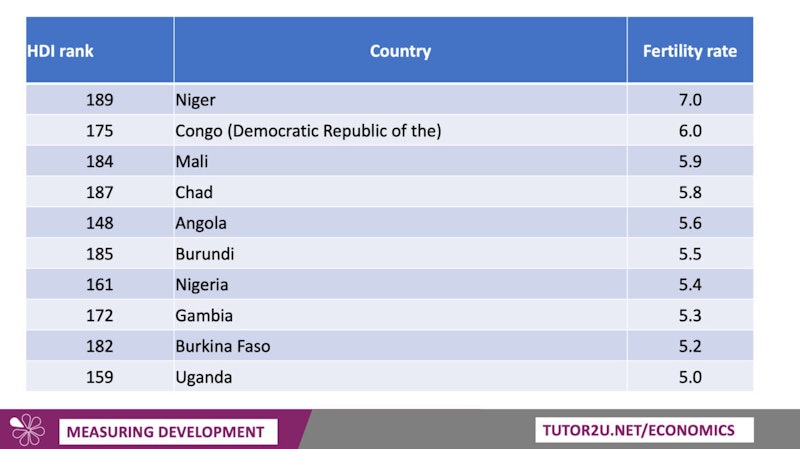Study Notes
To what extent are high fertility rates evidence for low economic development?
- Level:
- A-Level, IB
- Board:
- AQA, Edexcel, OCR, IB, Eduqas, WJEC
Last updated 12 Oct 2023
High fertility rates can be indicative of lower levels of economic development, but the relationship between fertility rates and economic development is complex, and multiple factors come into play. High fertility rates are often associated with the following aspects of lower economic development:

- Limited Access to Education: In less economically developed regions, access to education, particularly for girls and women, can be limited. Higher levels of education are often associated with lower fertility rates, as educated individuals tend to have more knowledge about family planning and greater opportunities for employment and career development, which can delay childbearing.
- Limited Access to Healthcare: In regions with lower economic development, access to quality healthcare, including reproductive and maternal healthcare, may be inadequate. This can result in a lack of access to contraceptives, family planning services, and maternal care, which can contribute to higher fertility rates.
- Economic Dependence on Children: In some low-income or agrarian societies, children are considered a source of labor and a form of social security in old age. As a result, families may desire more children to help with labor and support in later years. This economic dependence on children can lead to higher fertility rates.
- Cultural and Religious Norms: Cultural and religious beliefs can strongly influence family size and fertility rates. In some cultures or religious communities, having more children is encouraged or even seen as a religious duty, which can lead to higher fertility rates.
- Poverty: Economic underdevelopment can lead to higher levels of poverty. Families in poverty may lack the resources and access to family planning methods, which can result in higher fertility rates due to reduced ability to control family size.
- Lack of Women's Empowerment: In societies with low economic development, women may have limited decision-making power regarding reproductive choices. Greater gender equality and women's empowerment, which are often associated with higher development, can lead to lower fertility rates.
- Urbanization: As regions develop economically, there is often a shift from rural to urban living. Urban areas tend to have lower fertility rates due to factors such as increased access to education, employment opportunities, and family planning services.
It's important to note that while high fertility rates can be associated with lower economic development, this is not a deterministic relationship, and exceptions exist. Moreover, as countries and regions progress economically, fertility rates often decline due to improved access to education, healthcare, and economic opportunities.
It's also essential to recognize that fertility rates are influenced by a range of complex social, cultural, and economic factors, and reducing fertility rates is not always a simple linear process. Government policies, community-based initiatives, and international aid programs can play a role in helping to lower fertility rates in lower-income regions by addressing issues such as family planning, healthcare access, and women's empowerment.
You might also like
India - Economic Growth and Development
Study Notes

Assessing the predicted impact of climate change
13th November 2015

Paul Collier on African Urbanisation
16th June 2016
Risks for the Chinese Economy
Study Notes
Progress in Reducing Extreme Poverty
Study Notes
Poverty Reduction in Low Income Countries
Teaching PowerPoints

New Economic Thinking: Inequality - The Bigger Picture
4th February 2020
Daily Email Updates
Subscribe to our daily digest and get the day’s content delivered fresh to your inbox every morning at 7am.
Signup for emails